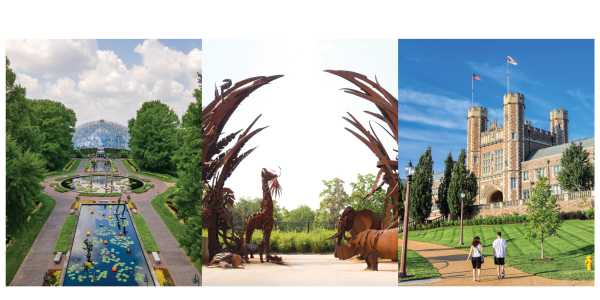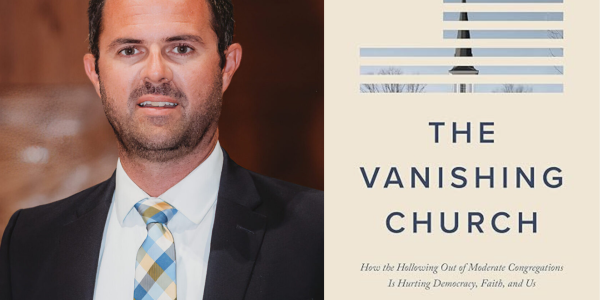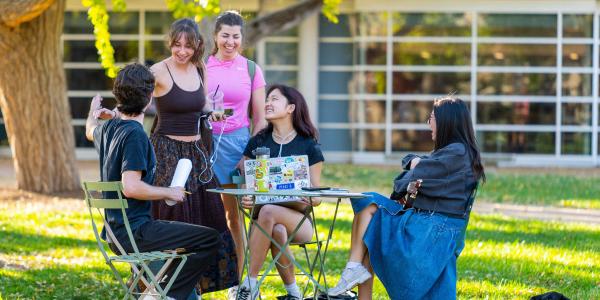Combining the forces of WashU, the Missouri Botanical Garden, and the Saint Louis Zoo, the Living Earth Collaborative works to protect the plants and animals of the world — for their sake and ours.
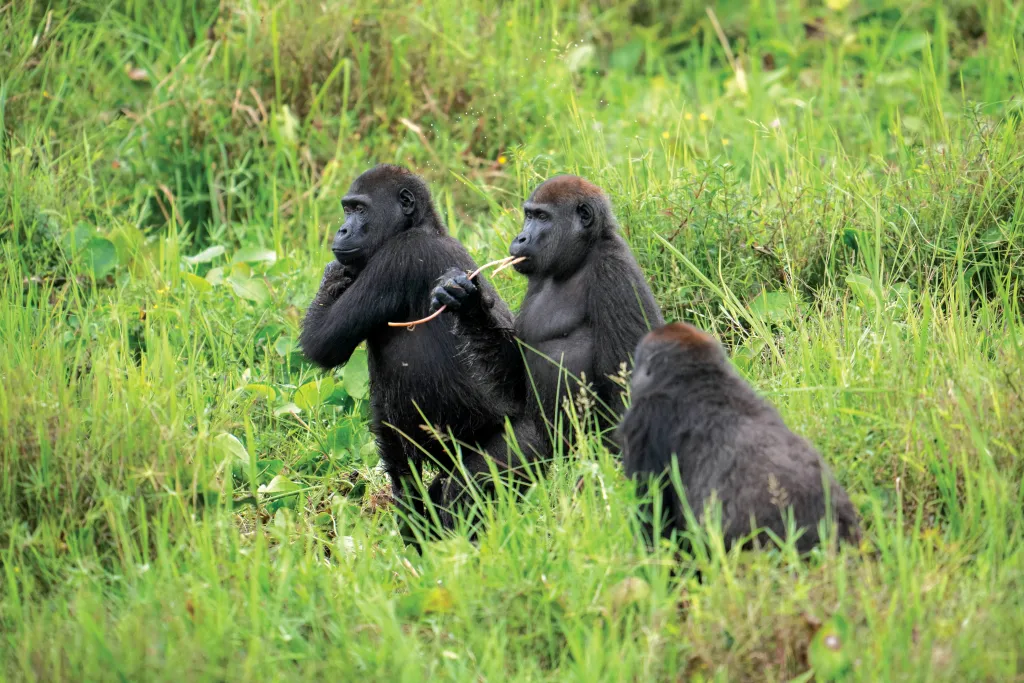
Wild chimpanzees will happily share their secrets, but first you must gain their trust. After many months observing chimps from a safe distance in the Goualougo Triangle of the Congo Basin, anthropologist Crickette Sanz made it to the inner circle.
Sanz, the James W. and Jean L. Davis Professor in Arts & Sciences, saw mothers teach their young to wield carefully crafted sticks to smash beehives or catch termites — the most elaborate tool use ever witnessed in non-humans. She also documented unmistakable friendships between chimps and western lowland gorillas, bonds that went against expected primate behavior. “Those two species are supposed to be competitors,” Sanz said. “But when a gorilla walks up to a party of chimps and sees a friend, the two will run up to each other and start playing.”
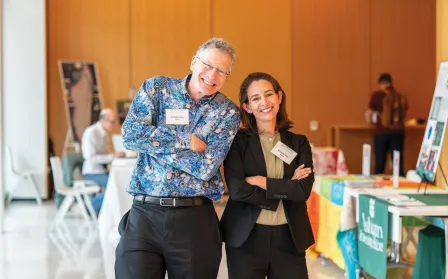
As co-director of the Living Earth Collaborative (LEC), Sanz knows all about the value of powerful partnerships. The initiative combines the resources of WashU, the Missouri Botanical Garden, and the Saint Louis Zoo to understand, protect, and promote biodiversity in St. Louis and around the world. Through extensive conversation and collaboration, the LEC’s researchers are addressing pressing environmental problems that would be too big for one institution to tackle on its own.
“We have something that’s close to unique,” said LEC co-director Jonathan Losos, the William H. Danforth Distinguished University Professor. “We’ve got a great university, one of the world’s leading centers of botanical scholarship, and a fantastic zoo with a fabulous conservation program all within a few miles of each other. This gives us a chance to do scientifically and societally important things that other institutions can’t match.”
Sanz couldn’t do her research in the Congo on her own. Funding from the zoo enabled her to hire Congolese field assistants and pay for expensive motion-sensing cameras that can monitor the chimps 24/7. She also relied on primate experts at the zoo to review the many hours of footage to ensure that rare and elusive species caught on camera were correctly identified.
Now, thanks to new hires and its inclusion in the Arts & Sciences Strategic Plan, the LEC is poised to expand its impact and its reach. Future efforts will focus on three key aspects of biodiversity: tropical forest conservation, urban plants and wildlife, and the nexus of nature conservation and human well-being, a crucial but often overlooked factor in conservation work. “The health of people and the health of the environment are inextricably linked,” Losos said.
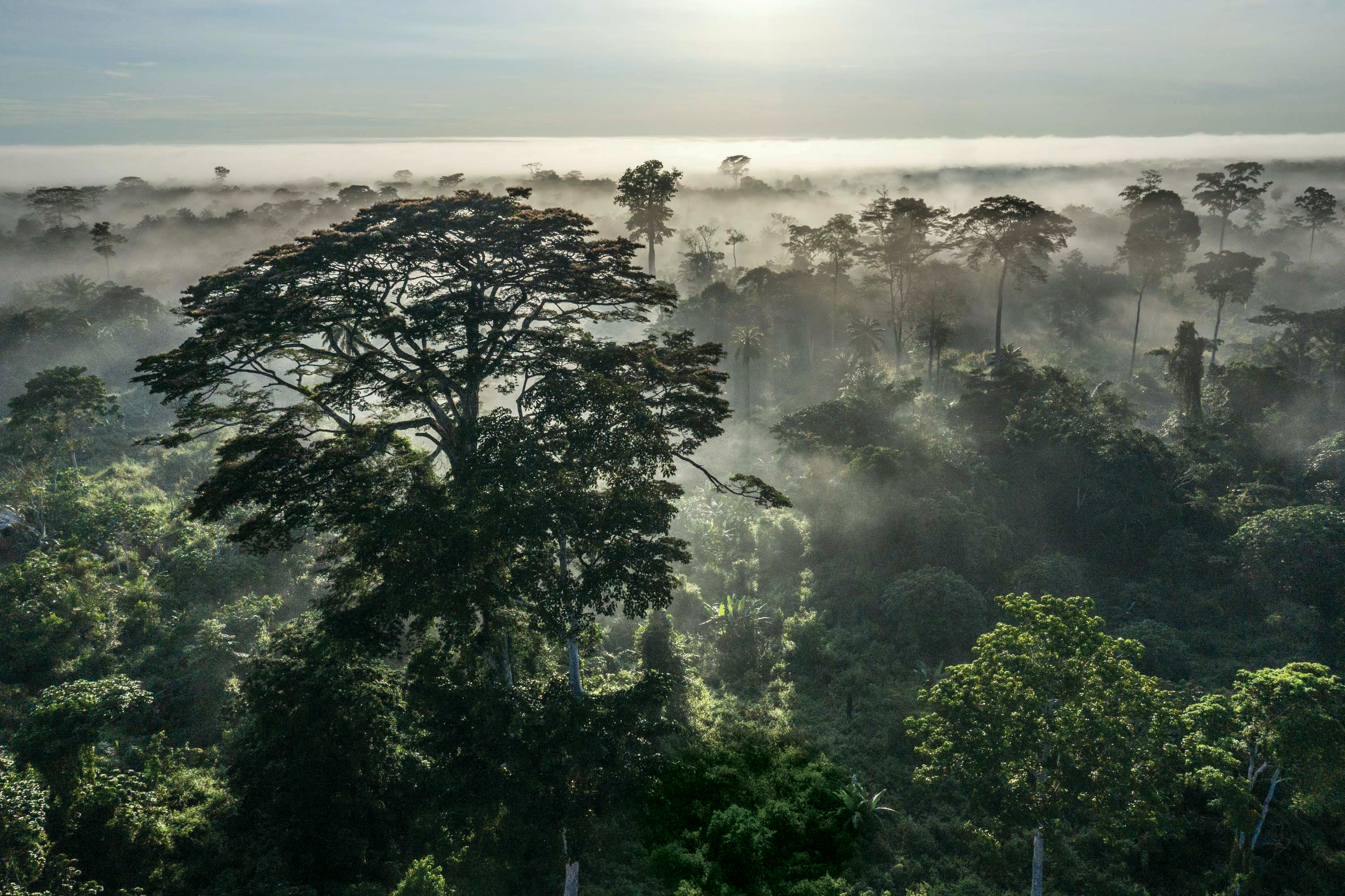
A garden for the world
The Missouri Botanical Garden — a sprawling, growing enterprise with tendrils in Asia, Africa, Latin America, and Europe — adds a crucial element to the LEC’s mission, said Gunter Fischer, the garden’s senior vice president of science and conservation. “The Missouri Botanical Garden’s programs operate locally and throughout the world to address key challenges facing humanity by empowering stakeholders to manage, protect, and restore biodiversity sustainably,” he said.
The LEC is quickly building momentum with the addition of two new faculty members who will strengthen WashU’s ties with the Missouri Botanical Garden and expand the cohort’s international network. In January, renowned botanist Lúcia Lohmann, previously a professor at the University of California, Berkeley, and the University of São Paulo in Brazil, joined the LEC as the president and director of the garden and the George Engelmann Professor of Botany at WashU. Toby Pennington, a leading expert in tropical ecology, will leave his position at the University of Exeter in the U.K. to become the first David and Dorothy Kemper Professor, a joint appointment between WashU and the garden.
Pennington’s work is focused on plants in dry tropical forests, some of the most productive, diverse, and fragile habitats in the world. More than half of the tropical regions of Latin America, sub-Saharan Africa, and Southern Asia lack the moisture to support true rainforests, but they still brim with a profusion of plants, including many that have yet to be properly identified and inventoried.
“The Missouri Botanical Garden has one of the world’s largest collections of plants from tropical Latin America,” Pennington said. “You don’t necessarily need to go to a remote area of Brazil or Peru to find them. It’s going to be much easier for me to do my work with that collection on my doorstep.”
Pennington plans to lead future expeditions to Latin America for on-the-ground surveys. He helped build an international network of more than 80 researchers who are studying 2,000 tropical dry forest sites across the region. Those stretches of forest still hold many secrets that could be uncovered through research trips, potentially involving teams of students and faculty from WashU, the garden, and the zoo. “There’s a huge opportunity for the LEC to document the full diversity of plants and animals on this network of study sites,” he said. “I would love to help bring it together.”
Lizards, lemurs, and coyotes
A world-renowned biologist, Losos has made his own landmark contributions to evolution, ecology, and conservation through his studies of anole lizards, colorful reptiles that range through much of the Americas, including Florida, the Caribbean, and Central and South America. “There are more than 400 species of anoles, and they all have their own adaptations to their habitats,” he said. “If you want to understand how diversity evolves, they’re a great organism to study.”
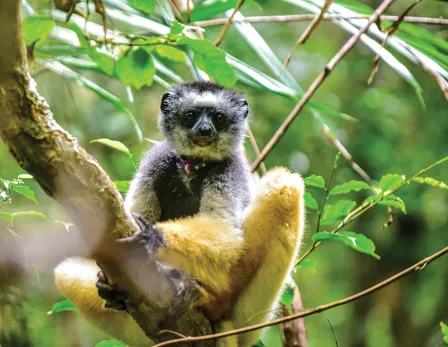
Despite decades of research by Losos and others, much work remains. Out of those 400 or so species of anole lizards, researchers have a comprehensive understanding of the biology of roughly 10, Losos said. For animals that are rare or elusive, even basic characteristics such as diets, breeding habits, and life spans remain mysterious. “For people who appreciate nature, this knowledge is important,” Losos said. “If we want to understand an animal and save it, we need to know how it works.”
The conservation of wildlife species is a key goal of the Saint Louis Zoo, a beloved St. Louis institution with global reach. The impact of a partnership like the LEC is especially apparent in Madagascar, an island of baobab trees, lemurs, tortoises, and other remarkable plants and animals. Researchers from the zoo, the garden, and WashU work together to study and protect the unique habitats of the island nation, including removing invasive plants such as strawberry guava and wild ginger from native forests. “Madagascar really stands out as an example of what the zoo and the LEC can accomplish,” said Lisa Kelley, a WashU alum who is now executive director of the Saint Louis Zoo WildCare Institute and director of the zoo’s Center for Conservation in Madagascar.
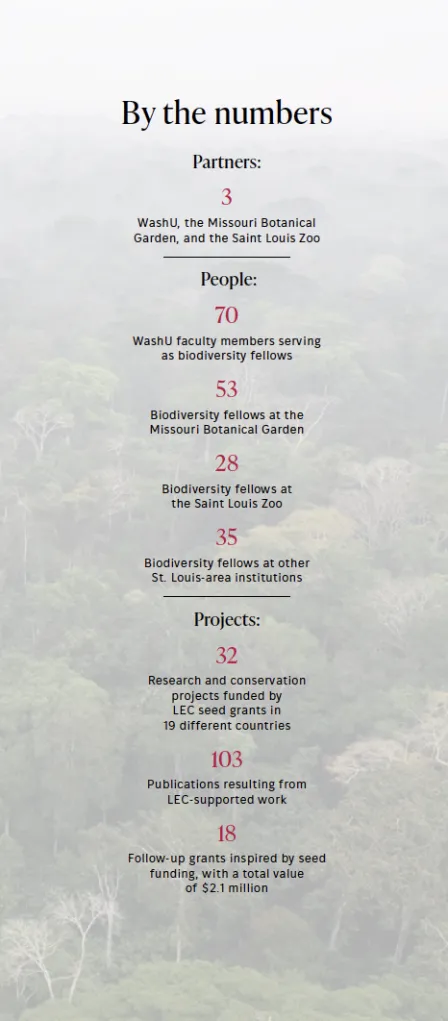
As part of its mission to promote urban biodiversity, the LEC also fosters animal research close to home. Elizabeth Carlen, a LEC postdoctoral fellow with WashU, published a 2025 study of coyotes, animals that have moved into St. Louis, Los Angeles, and other urban areas. The team identified specific genetic changes that may have helped coyotes adapt to life in the city, insights that could help scientists understand why some species thrive in urban environments while others struggle. The Forest Park Living Lab, another project supported by the LEC, is using motion-triggered wildlife cameras and GPS collars to study coyotes as well as a host of other species in and around Forest Park.
The zoo’s research, whether local or abroad, helps spotlight the importance of conservation. “People see us as a part of their community,” Kelley said. “When they learn about our work with our partners to protect biodiversity, they’re very supportive.”
Keeping people in the picture
Public support — along with the continued commitment of the three institutions — should help the LEC achieve its ambitious goals for 2025 and beyond, Losos said. He is especially excited to explore the connections between conservation and human health, a crucial topic given recent outbreaks of diseases that can spread from animals to humans. Research into the human side of nature conservation could involve multiple WashU departments, including the new School of Public Health. “We could really plant a flag in this critically important area of research,” Losos said.
In recent years, LEC researchers have studied ticks and mosquitoes in the St. Louis area, work with important implications for human well-being. Katie Westby, a staff scientist at Tyson Research Center, led a 2024 study that found some populations of mosquitoes near St. Louis and elsewhere are surprisingly resilient to heat, potentially bad news for disease transmission in a warming world. Tyson staff scientist Solny Adalsteinsson co-authored a 2023 study that found one out of 150 lone star ticks in the St. Louis area carry the Bourbon virus, an infectious agent that can cause fevers, body aches, and rashes. The researchers concluded that the tick-borne virus has likely already infected many people in the area, with more cases to come.
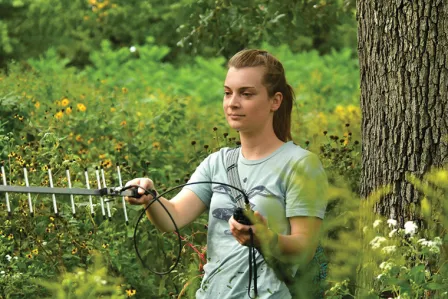
uses radio telemetry to track the movements of local animals in the St. Louis area. (Credit: Forest Park Living Lab)
Human well-being is already a key part of Sanz’s work in the Congo, where she engages with local communities to help people coexist with their primate neighbors. She discourages direct human interactions with chimpanzees and gorillas for the sake of all involved. The Ebola virus, for example, emerged in wildlife and then spread to humans, Sanz said, causing deadly outbreaks in several African countries. “Ebola was a reminder that animals need their own space.”
Sanz’s research with the LEC is making a difference. Inspired by her findings on the sophisticated cultures and intriguing behaviors of the resident great apes, the Republic of Congo expanded the boundaries of its Nouabalé-Ndoki National Park to include the Goualougo and Djéké Triangle study areas. In 2024, the United Nations Convention on Migratory Species adopted a concerted action to further protect the “behavioral diversity and cultures” of chimpanzees across equatorial Africa.
“We’ve already seen some incredible results, and there’s more to come,” Sanz said. “In the next few years, we’re going to see the LEC take more of a leading role in global conservation.”
This story appeared in the Spring 2025 issue of Ampersand magazine. See more stories from the magazine and browse our archives.

